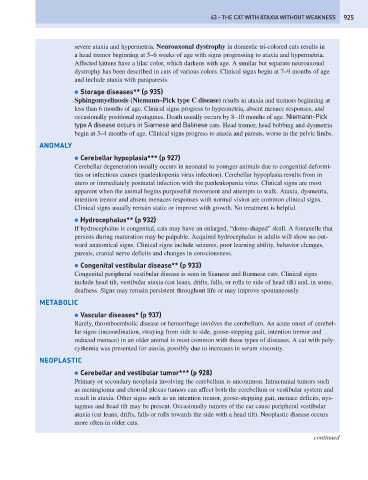Page 933 - Problem-Based Feline Medicine
P. 933
43 – THE CAT WITH ATAXIA WITHOUT WEAKNESS 925
severe ataxia and hypermetria. Neuroaxonal dystrophy in domestic tri-colored cats results in
a head tremor beginning at 5–6 weeks of age with signs progressing to ataxia and hypermetria.
Affected kittens have a lilac color, which darkens with age. A similar but separate neuroaxonal
dystrophy has been described in cats of various colors. Clinical signs begin at 7–9 months of age
and include ataxia with paraparesis.
● Storage diseases** (p 935)
Sphingomyelinosis (Niemann–Pick type C disease) results in ataxia and tremors beginning at
less than 6 months of age. Clinical signs progress to hypermetria, absent menace responses, and
occasionally positional nystagmus. Death usually occurs by 8–10 months of age. Niemann–Pick
type A disease occurs in Siamese and Balinese cats. Head tremor, head bobbing and dysmetria
begin at 3–4 months of age. Clinical signs progress to ataxia and paresis, worse in the pelvic limbs.
ANOMALY
● Cerebellar hypoplasia*** (p 927)
Cerebellar degeneration usually occurs in neonatal to younger animals due to congential deformi-
ties or infectious causes (panleukopenia virus infection). Cerebellar hypoplasia results from in
utero or immediately postnatal infection with the panleukopenia virus. Clinical signs are most
apparent when the animal begins purposeful movement and attempts to walk. Ataxia, dysmetria,
intention tremor and absent menaces responses with normal vision are common clinical signs.
Clinical signs usually remain static or improve with growth. No treatment is helpful.
● Hydrocephalus** (p 932)
If hydrocephalus is congenital, cats may have an enlarged, “dome-shaped” skull. A fontanelle that
persists during maturation may be palpable. Acquired hydrocephalus in adults will show no out-
ward anatomical signs. Clinical signs include seizures, poor learning ability, behavior changes,
paresis, cranial nerve deficits and changes in consciousness.
● Congenital vestibular disease** (p 933)
Congenital peripheral vestibular disease is seen in Siamese and Burmese cats. Clinical signs
include head tilt, vestibular ataxia (cat leans, drifts, falls, or rolls to side of head tilt) and, in some,
deafness. Signs may remain persistent throughout life or may improve spontaneously.
METABOLIC
● Vascular diseases* (p 937)
Rarely, thromboembolic disease or hemorrhage involves the cerebellum. An acute onset of cerebel-
lar signs (incoordination, swaying from side to side, goose-stepping gait, intention tremor and
reduced menace) in an older animal is most common with these types of diseases. A cat with poly-
cythemia was presented for ataxia, possibly due to increases in serum viscosity.
NEOPLASTIC
● Cerebellar and vestibular tumor*** (p 928)
Primary or secondary neoplasia involving the cerebellum is uncommon. Intracranial tumors such
as meningioma and choroid plexus tumors can affect both the cerebellum or vestibular system and
result in ataxia. Other signs such as an intention tremor, goose-stepping gait, menace deficits, nys-
tagmus and head tilt may be present. Occasionally tumors of the ear cause peripheral vestibular
ataxia (cat leans, drifts, falls or rolls towards the side with a head tilt). Neoplastic disease occurs
more often in older cats.
continued

